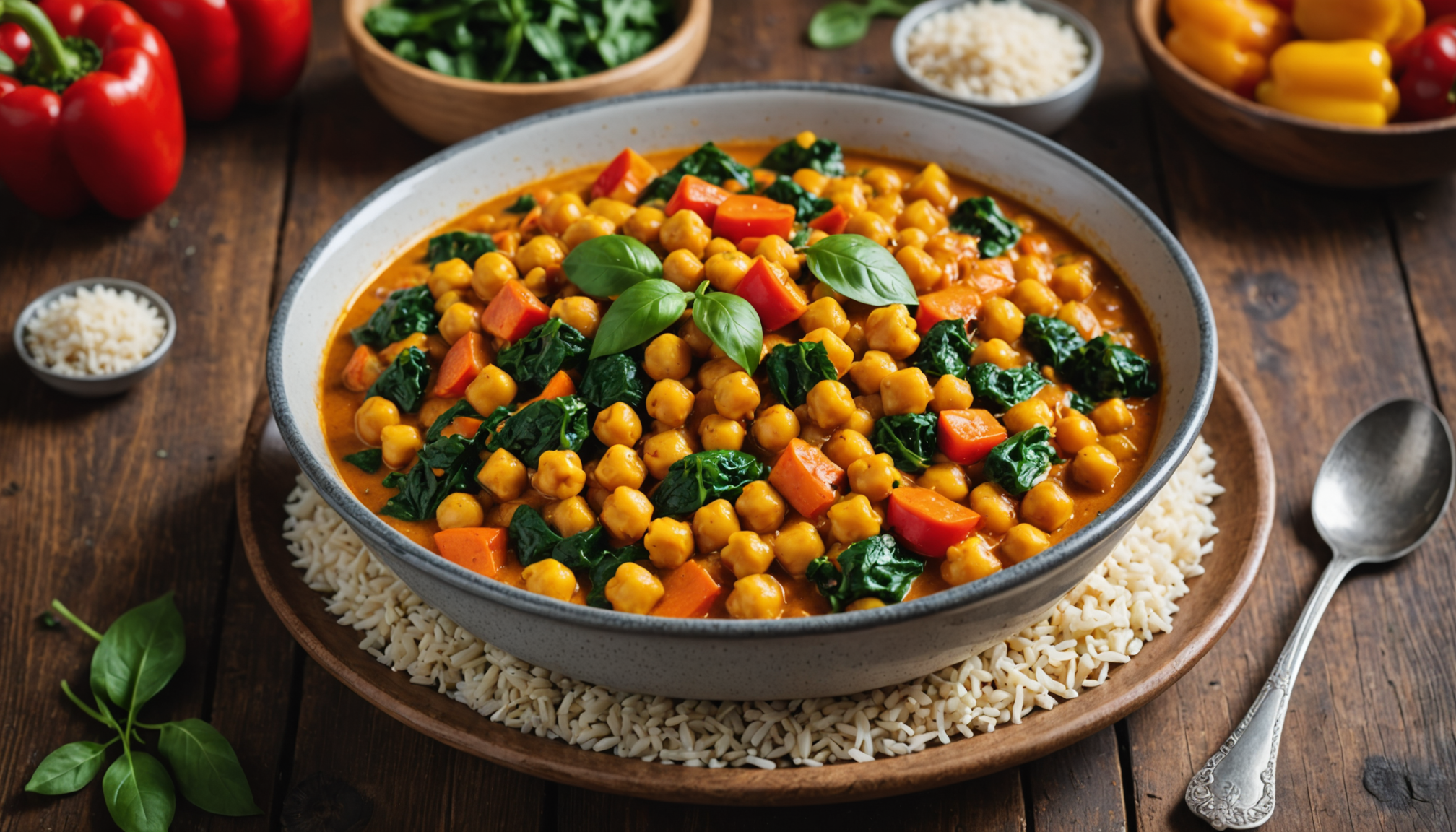- Benefits of Organic Ingredients
- Meal Planning for Busy Families
- Quick and Easy Organic Dinner Recipes
- Budget-Friendly Organic Shopping Tips
- Involving Kids in Healthy Cooking
- Nutritional Value of Family Meals
When it comes to grocery shopping, especially for families aiming to eat healthy, organic ingredients can be a game changer. Purchasing organic foods means supporting sustainable farming practices, reducing exposure to harmful pesticides, and often enjoying superior flavor. To make the most of your grocery excursions, whether you’re navigating a local farmer’s market or an online grocery platform, consider these tips for selecting the best organic ingredients:
- Know Your Sources: If you’re shopping locally, familiarize yourself with farmers’ markets and community-supported agriculture (CSA) programs. These options often provide organic produce that’s in-season and fresher than supermarket varieties.
- Seasonal Shopping: Eating with the seasons not only enhances flavor but also supports local economies. In the spring, you might enjoy asparagus and strawberries, while fall brings us pumpkins and apples. Check local listings for what’s currently in season.
- Online Appeal: When shopping online for organic products, read reviews and verify the integrity of the sources. Only purchase from reputable websites that specialize in organic and non-GMO goods to ensure safety and quality.
- Look for Certifications: Always check for organic certifications on packaging. In the U.S., labels like USDA Organic signify adherence to strict guidelines. Beware of terms like ‘natural’ or ‘free-range,’ as they do not always guarantee organic standards.
- Thrifty Choices: Organic items don’t have to break the bank. Buying in bulk, particularly for grains and legumes, can lead to significant savings. Be on the lookout for store sales or coupon opportunities.
- Produce Priority: Certain fruits and vegetables are known to have higher pesticide residues. Focus on purchasing organic for items on the Dirty Dozen list, which commonly includes strawberries, spinach, and apples. You can find this list updated annually by the EWG (Environmental Working Group).
- Alternatives for Ingredients: If you’re concocting organic recipes that require specialty items or ingredients, consider substitutions using pantry staples. For example, instead of organic coconut sugar, brown sugar can deliver similar tastes at a lower cost.
- Plan Ahead: Before heading to the store or browsing online, prep a list based on your meals for the week. This will minimize impulse buying and help you focus on filling your cart with essential items that support healthy family meals.
By incorporating these strategies into your grocery shopping routine, you’ll be well on your way to crafting delicious, healthy family meals that not only nourish but also delight. Organic shopping doesn’t need to be overwhelming; with a little preparation and awareness, you can create a sustainable and healthy pantry for your loved ones!
Meal Planning for Busy Families
When managing a family schedule that is often packed with activities, obligations, and last-minute changes, meal planning emerges as an essential strategy for ensuring that healthy, organic meals are consistently on the table. A well-structured meal plan can reduce stress, streamline grocery shopping, and most importantly, foster healthier eating habits across the family.
A fundamental aspect of meal planning involves designating one day a week—often a Sunday for busy families—to plan meals for the upcoming week. During this designated time, families can brainstorm dinner ideas that incorporate a variety of organic ingredients, ensuring a diverse and balanced diet. Here are some practical steps to optimize the meal planning process:
1. Create a Weekly Menu: Sit down as a family and involve everyone in decisions about meals. List out dinner ideas that utilize organic ingredients. This inclusion not only encourages children to be excited about the meals but also promotes a sense of teamwork and responsibility with food choices.
2. Categorize Meals: Organizing dinner ideas by themes, such as ‘Meatless Mondays’, ‘Taco Tuesdays’, or ‘Soup Sundays’, can provide structure and ease when planning. This way, you can incorporate different cuisines and cooking methods while making the most of the ingredients you purchase.
3. Batch Cooking and Prep: To save time during the week, consider batch cooking certain components of meals. For example, cooking a large pot of organic quinoa or a big batch of roasted vegetables at the start of the week means you have versatile components ready to be transformed into various dishes. Store them in containers for quick access.
4. Balancing Fresh and Pre-prepared Ingredients: While fresh organic ingredients are ideal, sometimes convenience items like pre-chopped organic vegetables or frozen organic fruits can be lifesavers for quick meals. Incorporating these items appropriately can cut down on prep time without sacrificing nutritional value.
5. Utilize Leftovers Creatively: Plan meals that enable the use of leftovers in a creative way. For instance, grilled chicken can become a filling for salads, wraps, or pasta dishes later in the week. This not only minimizes waste but effectively reduces daily cooking time.
| Day | Dinner Ideas | Main Ingredients |
|---|---|---|
| Monday | Vegetarian Stir-Fry | Organic tofu, broccoli, bell peppers, soy sauce |
| Tuesday | Organic Turkey Tacos | Ground turkey, organic tortillas, lettuce, tomatoes |
| Wednesday | Quinoa Salad | Organic quinoa, cucumbers, cherry tomatoes, feta |
| Thursday | Baked Salmon with Veggies | Organic salmon, asparagus, lemon, garlic |
| Friday | Homemade Pizza | Organic pizza dough, tomato sauce, mozzarella, vegetables |
| Saturday | Chili with Beans | Organic beans, tomatoes, chili spices, bell peppers |
| Sunday | Soup and Bread | Organic lentils, carrots, celery, vegetable broth |
By adopting a systematic approach to meal planning, families can not only save time but also ensure they are consistently preparing nutritious meals that everyone enjoys. The effort placed in organizing meals leads to more healthy organic dinners that help to establish a routine of shared meals, contributing positively to the overall well-being of the family. Through this collective dining experience, families can engage in meaningful conversations while enjoying the benefits of nutritious, home-cooked meals.
Quick and Easy Organic Dinner Recipes

When it comes to whipping up quick and easy organic dinner recipes, the process should feel less like a chore and more like an adventure. By focusing on simple ingredients and straightforward methods, you can create satisfying meals that cater to families, fitness enthusiasts, and busy professionals alike. Here are some fun and practical ideas to inspire your dinner plans without the fuss:
- Flexible Base Ingredients: Start with a few staple ingredients that can be turned into numerous meals. For instance, organic quinoa, brown rice, or whole wheat pasta serve as great bases for many dishes. You can quickly transform them into a variety of family meals by adding diverse vegetables, proteins, or sauces.
- One-Pan Wonders: Simplify cleanup and prep by opting for one-pan meals. These recipes can include an assortment of organic vegetables and your choice of protein, all tossed together and roasted or sautéed. For example, a one-pan bake with organic chicken, sweet potatoes, and broccoli can come together in under 30 minutes.
- Quick Stir-Fries: Stir-fries are perfect for using up leftover veggies. Just toss them into a hot pan with some organic tofu or chicken, and dress with a simple sauce made from soy sauce or tamari, ginger, and garlic. In no time, you have a balanced, colorful dish ready to serve.
- Batch Cooking: Consider preparing larger quantities of certain dishes and storing them. Homemade soups, stews, and chili can provide hearty options throughout the week. Having these dishes ready in the fridge means you can quickly heat a satisfying family meal without cooking from scratch every night.
- Versatile Wraps: Use organic tortillas or lettuce leaves to create wraps filled with various fillings: think roasted vegetables, hummus, or organic deli meats. These are not only quick to prepare but also let everyone customize their meals to their liking.
- Incorporate Frozen Foods: Don’t overlook the power of frozen organic fruits and vegetables. They are often picked at peak freshness and can be just as nutritious as fresh options. Add frozen peas, corn, or spinach to your pasta dishes or omelets for ease without skimping on health.
- Healthy Sauces and Dressings: Elevate simple recipes with homemade sauces. A quick blend of olive oil, balsamic vinegar, and herbs can work wonders on salads or grilled veggies. Making a batch of homemade tomato sauce with organic tomatoes can also add depth to any dish.
For an ultra-easy weeknight dinner idea, consider preparing a savory vegetable and chickpea curry. Using canned organic chickpeas, coconut milk, and whatever vegetables you have on hand, such as spinach, bell peppers, and carrots, allows you to create a fragrant meal in only 20 minutes. Serve it over your choice of whole grain or with quinoa for a complete family meal that tastes gourmet but takes minimal effort.
Whether you’re cooking for the whole family or just yourself, the key is to maintain a repertoire of go-to organic recipes that are both delightful and easy to prepare. Emphasizing simplicity while using wholesome organic ingredients can make weeknight dinners a treat rather than a hassle.
Budget-Friendly Organic Shopping Tips
 When shopping on a budget for organic ingredients, there are several strategies you can employ to keep costs manageable while still prioritizing health and nutrition. The right approach can allow you to fill your pantry and fridge with fresh, organic foods without feeling guilty about overspending. Here are some practical tips to help you navigate your organic shopping experience more affordably:
When shopping on a budget for organic ingredients, there are several strategies you can employ to keep costs manageable while still prioritizing health and nutrition. The right approach can allow you to fill your pantry and fridge with fresh, organic foods without feeling guilty about overspending. Here are some practical tips to help you navigate your organic shopping experience more affordably:
Start by making price comparisons between local stores and grocery chains. Some supermarkets have dedicated sections for organic products, while others may charge a premium. Additionally, local co-ops often offer competitive prices on organic goods—especially in bulk. Frequenting multiple stores for different items can yield savings.
“It does not matter how slowly you go as long as you do not stop.” — Confucius
Consider signing up for newsletters or loyalty programs from your preferred stores. Many retailers offer exclusive discounts, coupons, and notifications for sales on organic foods, which can lead to savings over time. Utilizing these tools effectively allows you to stay informed and capitalize on pricing.
Buying organic in bulk is also a smart decision. Look for items like grains, seeds, and nuts that you can purchase in larger quantities. Many stores have bulk bins that not only offer a cost-effective way to buy organic ingredients but also allow you to take as much or as little as needed. This approach minimizes waste and maximizes your budget.
Keep an eye out for seasonal sales. As with any produce, organic fruits and vegetables often go on sale when they are in season. Plan your meals around these items to take advantage of lower prices and ensure you’re eating the freshest produce available.
Don’t shy away from frozen organic goods. Frozen fruits and vegetables maintain their nutritional value and are often less expensive than their fresh counterparts. They can easily be added to dishes like smoothies, stir-fries, or casseroles, providing convenience and quality at a better price.
Plan your meals and create a shopping list before heading out. This practice can help reduce impulse buys, ensuring your budget is spent solely on what you require. By sticking to your list, you can focus on necessary organic ingredients for healthy family meals without swaying towards cheaper processed options that may be tempting.
Lastly, while it may be more challenging, consider growing some of your own organic produce. Even a small herb garden or a few vegetable pots on a sunny windowsill can supplement store-bought ingredients and reduce costs over time. Many easy-to-grow options include herbs like basil, mint, or even compact tomato plants.
By implementing these budgeting strategies, you can successfully navigate the organic market without straining your wallet. The key is being resourceful and proactive, making the process of incorporating organic foods into your family meals not only feasible but enjoyable.
Involving Kids in Healthy Cooking
 Engaging children in the kitchen not only equips them with valuable life skills but also fosters a love for healthy, homemade meals. By involving kids in the cooking process, you create opportunities for them to learn about nutrition, develop an appreciation for fresh ingredients, and build memories that can last a lifetime.
Engaging children in the kitchen not only equips them with valuable life skills but also fosters a love for healthy, homemade meals. By involving kids in the cooking process, you create opportunities for them to learn about nutrition, develop an appreciation for fresh ingredients, and build memories that can last a lifetime.
Start by assigning age-appropriate tasks. Younger children can wash vegetables, measure ingredients, or even help tear herbs for salads. As they grow older, they can progress to chopping vegetables with supervision or even cooking simple dishes. This gradual increase in responsibility helps them build confidence and a sense of achievement in their cooking skills.
Consider involving children in the decision-making process when planning meals. Allow them to choose from a selection of organic recipes during your meal prep sessions. This not only encourages autonomy but also invites discussions about different ingredients and nutritional values, turning meal preparation into an educational experience. For example, if they have a choice between a colorful vegetable stir-fry and a pasta dish, you can delve into the benefits of the ingredients together, such as the vitamins in bell peppers and the fiber in whole-grain pasta.
You might also try themed cooking nights to keep their interest high. Create a “Taco Tuesday” or “Pasta Friday” where they can experiment with different toppings or sauces. They could make their own taco filling from organic ground turkey or black beans, learning to identify quality ingredients in the process. Cooking together encourages teamwork and creativity, and the excitement of preparing a meal can make even the pickiest eaters more open to trying new foods.
Teaching kids to cook is about more than simply preparing meals; it’s about empowering them to make healthier choices as they grow. Consider incorporating small challenges like “Try One New Vegetable” where each family member must select a new vegetable to include in that week’s meals. Emphasizing the fun of trying new and nutritious foods nurtures a positive relationship with food.
Cooking can also be an opportunity to instill organizational skills. Let kids help plan the grocery list based on your meal ideas, teaching them how to choose organic products wisely while staying within a budget. They can learn to read labels and spot certifications, ultimately gaining critical thinking skills relevant to food choices.
By weaving both education and fun into mealtime preparation, you are not just feeding your family; you are equipping the next generation with knowledge and skills that will benefit them throughout their lives. The kitchen can become a nurturing environment where creativity, health, and family bonding come together to create wholesome dinners everyone enjoys.
- How can I get my kids interested in cooking?
- Start by giving them simple tasks that suit their age, like washing vegetables or measuring ingredients. Involving them in fun themes or allowing them to choose recipes can spark their interest and keep them engaged.
- What are some easy organic recipes for kids to try?
- Consider simple dishes like homemade tacos, smoothies with frozen organic fruits, or vegetable stir-fries. These dishes allow for creativity and can be adjusted based on your kids’ preferences.
- How can I ensure the meals I prepare are healthy?
- Focus on incorporating a variety of colorful fruits and vegetables, whole grains, and lean proteins into your meals. Plan your meals around fresh, organic ingredients to maximize nutrition.
- What are some tips for cooking with young kids?
- Always supervise them closely and choose simple tasks they can handle. Focus on safety and fun, using cooking as an opportunity for learning about flavors and textures.
- What should I do if my kids are picky eaters?
- Encourage them to try new foods by involving them in the cooking process and making it a fun experience. Try new recipes together, and avoid pressure to eat; instead, praise them for trying something new.
- Can cooking together strengthen family bonds?
- Absolutely! Cooking together fosters teamwork and communication, creating shared experiences that can strengthen relationships while providing valuable life skills.
- How often should we involve kids in meal preparation?
- Make it a regular part of your routine. Weekly cooking dates or theme nights can be a great way to ensure they are actively involved in preparing family meals.
Nutritional Value of Family Meals

The nutritional value of family meals extends far beyond just the ingredients; it encapsulates the experiences and bonding moments shared during meal preparation and consumption. When families embrace the practice of cooking together, not only do they create nourishing dishes, but they also instill healthy eating habits and a lifelong appreciation for good food in their children. Meals prepared with organic ingredients offer numerous benefits, but understanding how to maximize their nutritional potential is key.
First, consider the diversity of ingredients you incorporate into your family meals. Aim for a colorful plate by including a variety of organic vegetables, fruits, whole grains, and proteins. This not only enhances the flavor and visual appeal of your dishes but also provides a broad spectrum of vitamins and nutrients. For example, combining vibrant vegetables like organic carrots, bell peppers, and spinach brings a mix of Vitamin A, C, and K to the table, promoting better eyesight, immunity, and bone health.
It’s essential to prioritize cooking methods that retain and enhance the nutritional benefits of your ingredients. Baking, steaming, and sautéing with a small amount of healthy fats, like extra virgin olive oil, are generally healthier options than frying. These cooking techniques help preserve the nutrients found in many organic vegetables, allowing families to enjoy their health benefits fully.
Another aspect to consider is the portion sizes served during meals. Teaching children about balanced portions through visual models can empower them to understand appropriate serving sizes. For instance, using the plate method—filling half of the plate with vegetables, one quarter with whole grains, and the remaining quarter with protein—helps visualize balance and moderation. This approach builds a foundation for mindful eating as kids grow.
Don’t overlook the importance of engaging meal discussions during family dinners. Discussing where ingredients come from, what makes them healthy, and how they fit into overall nutrition encourages children to be curious about food. For instance, by explaining the benefits of omega-3 fatty acids found in organic salmon, you can turn a simple meal into an interactive and educational experience.
For families short on time, implementing quick and easy organic recipes can still yield nutritious outcomes. One-pot meals, such as organic vegetable and lentil stew, or stir-fries with organic chicken and a mix of colorful vegetables, deliver great nutrition without excessive cleanup. These dinner ideas are not only efficient but also emphasize the beauty of wholesome ingredients that everyone can enjoy together.
Lastly, remember that consistency is vital for establishing a culture of healthy eating. Make it a goal to sit down together as a family for at least a few meals each week. This habit not only allows families to connect but reinforces the nutritional values being taught. Gradually, these collective experiences foster a deep-rooted appreciation for the health benefits derived from thoughtfully prepared family meals. Always be on the lookout for creative and nourishing organic recipes to keep mealtime excitement alive and understand that maintaining a healthy lifestyle is a continuous journey you take together as a family.
New Customers Offer!
Free Gift for the new customer
$24 Value, When You Subscrib Visit Thrive Market












